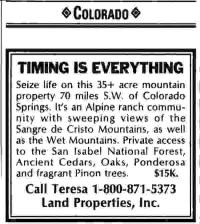Brief by Central Staff
Forests – November 2002 – Colorado Central Magazine
This recent Wall Street Journal ad for mountain real estate promises some “Ancient Cedars” on 35+ acres that must be somewhere in the Westcliffe area. However, it’s unlikely that there are any cedars, ancient or modern, on the property.

The evergreens hereabouts that are often called “cedars” occasionally are almost certainly junipers. According to the Audubon Society Nature Guide to Western Forests, the only true cedar that grows naturally in the Rocky Mountains is the Western Red Cedar. Its primary habitat is British Columbia, although it extends as far south as western Montana — a long way from Colorado. One big difference is size: this cedar can grow to 150 feet, while 50 feet is big for a juniper.
Like cedars, junipers don’t have needles (their thin evergreen leaves look like little hands), and their wood has a pleasant aroma. Junipers often grow in dry foothills along with piñon — thus the expression “pin-june forest.”
Junipers come in several varieties in this part of the world. Most common is the Rocky Mountain Juniper. The Utah Juniper can be found west of the Divide, and the small Oneseed Juniper’s habitat extends from the Upper Arkansas Valley south to northern Mexico.
This crossed nomenclature is not confined to advertising for Colorado real estate. We have a relative in Texas who insists that the common junipers of the Hill Country are actually “God-damn cedars,” since that’s all he ever heard anyone call them.

